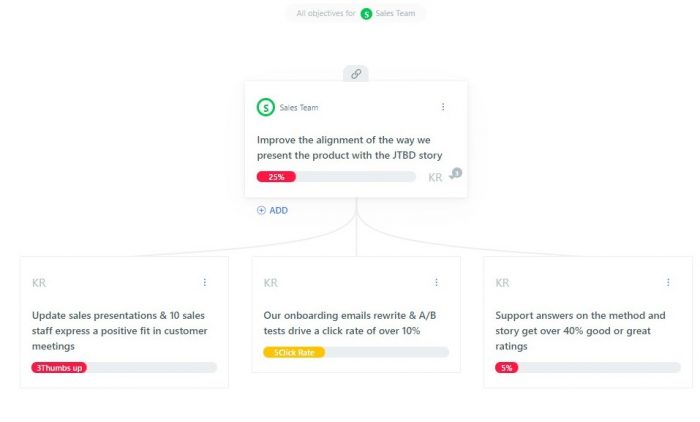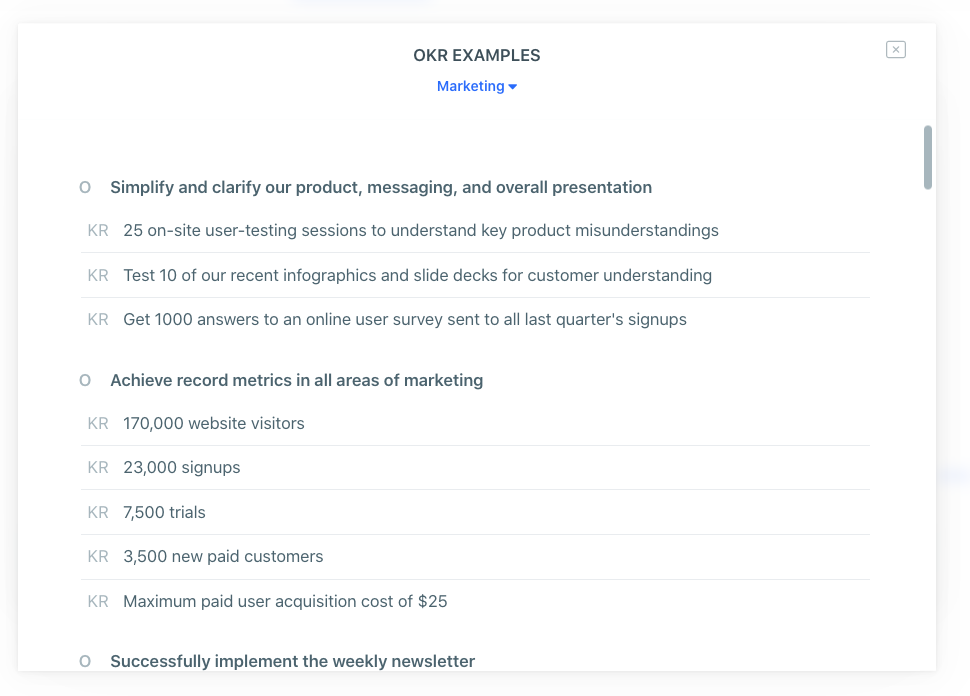Congratulations on your decision to take your company goals to the next level! With the popular OKR framework you’re on your way to that big picture visionary objective with more clarity, direction, and motivation to do so.
The Objectives and Key Results methodology encompasses a common company objective that gets all team members working in a particular direction. Qualitative objectives and quantitative key results make up the primary components of OKRs. The OKR process and definite structure guides you toward more realistic outcomes.
We’ll keep this article short and sweet – sharing best practices for setting Objectives and Key Results in the company and teams along with 9 frequently asked questions on the topic.
How Many OKRs Should We Set?
The perfect amount of OKRs for your organization really depends on variables specific to the company itself. For example: the specific long-term company vision, the amount of available resources, budget agreements, your organizational structure and hierarchy, as well as an evaluation of specific pain points you’d like to address and improve.
One commonality is that all organizations can benefit from the “less is more” mentality. Keeping things simple in order to stay focused on what really matters and drive that impact!
Let’s dive into the 2 major entities that set OKRs and how to properly do so:
1. The Company
A company itself can set between 1 and 4 OKRs. The company OKR should capture the overall vision and be determined as a long-term strategy (annual), with the notion that it will be broken down into 4 (quarterly) focus areas during the year.
Setting one OKR on the company level is a top-down approach where Key Results are assigned to the teams. So – if this is your management style you may find it easiest for the executive leaders to set 1 Objective and 3-7 Key Results per quarter.
However, since the OKR methodology helps align, focus, and connect businesses – we recommend setting only Objectives on the company level. By setting one Company Objective and aligning Team OKRs to that statement, you’ll create a more purposeful Company OKR – where Team Objectives become the Company Key Results.

Therefore, keeping these goal alignment best practices in mind – the number of Key Results a company has will depend on how many teams are contributing to the Objective. Each team is responsible for a specific Key Result, moving the Company Objective forward as collective progress is made.
2. The Teams
Individual teams in the organization should stick to one OKR per quarter. This ensures proper accountability, focus and concentration of their effort on a single purpose.
This means per quarter, each team should have 1 Objective with 3 to 5 Key Results.

Once the Company Objective is agreed upon and communicated to the teams, it is then up to teams to individually discuss their focus point for the quarter and how those will contribute to the big picture.
🎯 If your company has more than 100 employees you may decide to set OKRs on 3 levels – Company, Department, and Teams. Department-level objectives provide direction and focus for teams within that department. In Weekdone you have the option to set OKRs on all 3 levels if needed.
9 FAQ about Setting OKRs
1. How many OKRs should an organization have?
Organizations should have between 1 and 4 OKRs throughout one year. More than 4 can curtail an organization’s capacity to focus on vital objectives. 1 company OKR per quarter for an organization is the sweet spot!
Now, whether you change that Company Objective each quarter will depend on discussions with your teams and the progress made. Facilitating an OKR quarterly review will help determine next steps for the new quarter. Did you achieve the outcomes you set out for? Where can you adjust?
Some companies work with the same Objective for multiple quarters and let the teams adjust their OKRs to test new ideas and shooting for the moon!
2. Can you have more than one OKR?
Teams should decide on one OKR per quarter. Therefore, 4 OKRs in a year. Having a single OKR per quarter allows the team to focus on one objective at its relative key results in order to boost the chances of success.
If you’re a larger organization with many departments and teams – this can change. But remember to always air on the side of “less is more”. 😉
3. How many objectives should OKRs have?
An OKR should have one objective. The success of this objective is then measured by the agreed upon 3 – 5 quantifiable key results. As progress is made on these key results, a marked metric value will increase the objective.
4. How many individual OKRs are there?
At Weekdone, we do not promote personal OKRs as it creates an independent culture. Rather, OKRs are a collaborative effort – with contributions from everyone. Keeping objectives at the team level with responsible individuals to drive specific key results. Additionally it’s important to note that, OKRs should never be used as a performance management tool – they should never be tied to compensation.
Rather than individual OKRs – employees can set initiatives (projects), and weekly tasks and plans that help them see how everything connect to the team and company OKRs.

5. How do you cascade OKRs?
Instead of cascading OKRs by assigning high-level OKRs to individual employees, department supervisors, and team leaders – we recommend better OKR alignment and linking Team OKRs to Company Objectives. Keeping that collaboration and cohesive team environment across the entire organization.
6. How is OKR different from KPI?
OKR is time-bound, while KPI isn’t. OKR represents a strategic model for setting goals, while KPIs are metrics within a particular framework.
📚 Read more about OKRs vs. KPIs
7. Can OKRs be qualitative?
The objectives set in OKRs are qualitative, they should be written as a statement . The key results of an OKR are quantitative.
🤓 Read to understand how to write actionable goals with OKRs
8. What is OKR methodology?
The OKR methodology is a goal setting framework that focuses on Objectives and measurable outcomes that keeps everyone working in a particular direction. The popular framework encourages engagement and creates alignment within individuals, teams, and the entire organization.
📖 More on this in our OKRs Ultimate Guide
9. What is an OKR strategy?
An OKR strategy is a way to connect your long-term company vision and mission to short term actionable goals. With the OKR methodology teams can use the strategy as inspiration for setting realistic yet aspirational objectives with quantitative metrics to track progress.
The OKR strategy is best implemented by someone in your organization who is the designated OKR Champion. This person ensures that the broad organizational strategy is always top of mind while teams are setting OKRs quarter after quarter.
Writing OKRs – Examples for Inspiration
Good OKRs help teams remain laser-focused on vital priorities and ignite engaging conversations. John Doerr’s formula for OKRs should help to make writing OKRs clear:

💡 Bookmark our OKR examples resources page to refer back to each quarter!
While setting OKRs in Weekdone – you’ll be given examples on both the team and company level.

Bottom Line
The OKR methodology allows you to empower your team and develop clear priorities. The methodology, when used as a company wide goal setting, tracking and review process, will boost employee engagement and promote innovation.
Should you need assistance in your OKR goal management activities, Weekdone provides you with structured software to simplify process. Our team of experienced OKR coaches are there for you with each step – book a product demo today!
